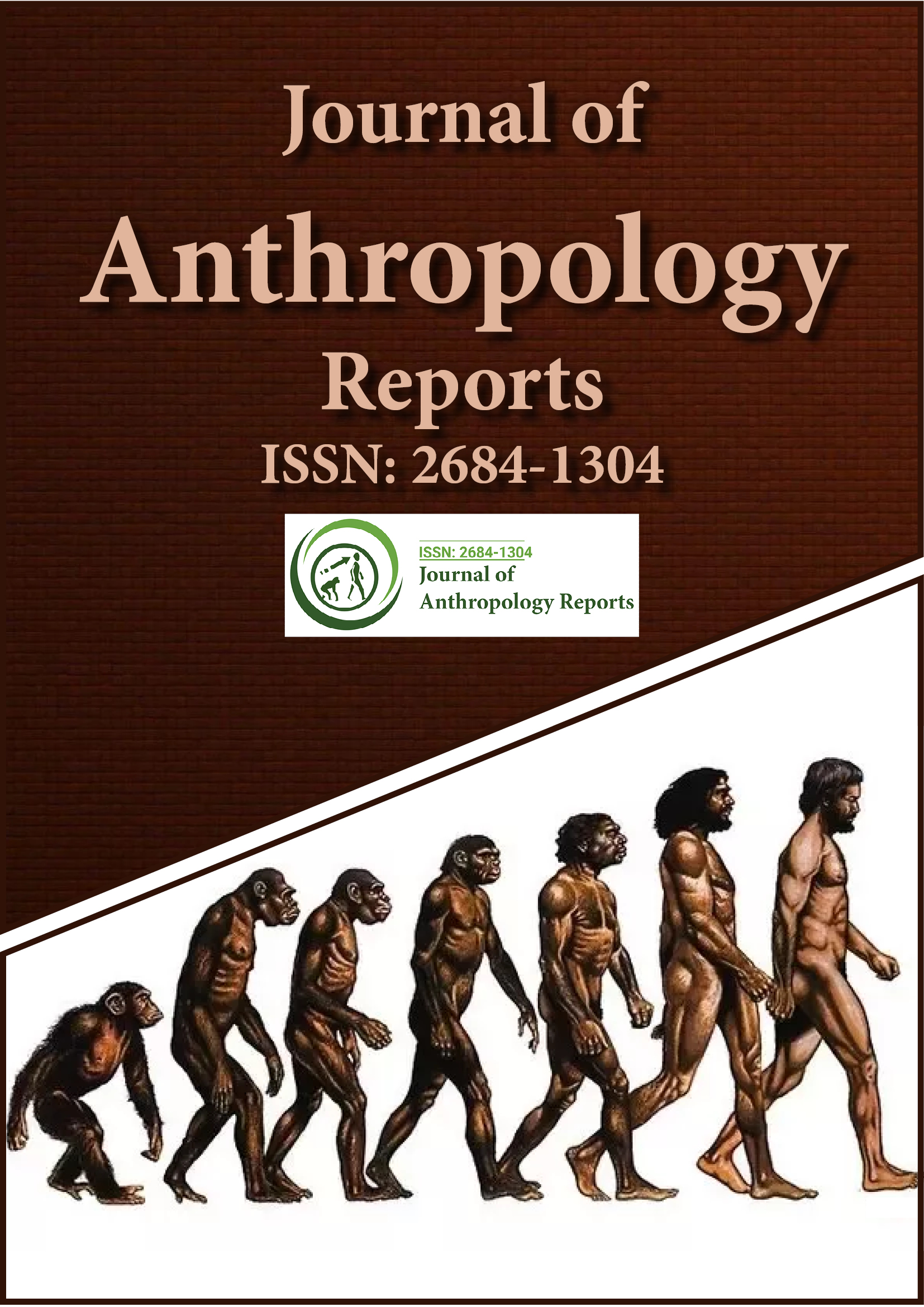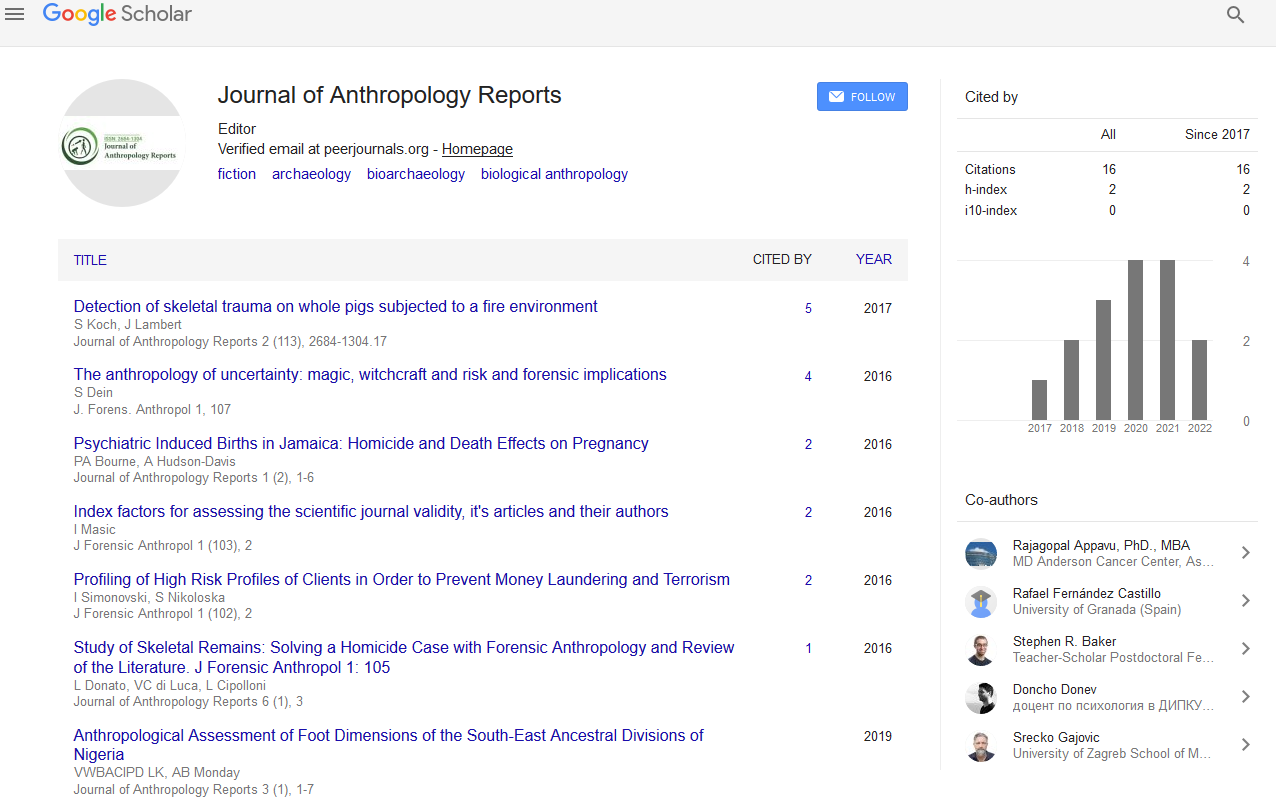Indexed In
- RefSeek
- Hamdard University
- EBSCO A-Z
Useful Links
Share This Page
Journal Flyer

Open Access Journals
- Agri and Aquaculture
- Biochemistry
- Bioinformatics & Systems Biology
- Business & Management
- Chemistry
- Clinical Sciences
- Engineering
- Food & Nutrition
- General Science
- Genetics & Molecular Biology
- Immunology & Microbiology
- Medical Sciences
- Neuroscience & Psychology
- Nursing & Health Care
- Pharmaceutical Sciences
Commentary - (2023) Volume 6, Issue 2
Importance of Data Gathering Methods in Forensic Anthropology
Nicole Lotering*Received: 19-Jun-2023, Manuscript No. JFA-23-21910; Editor assigned: 21-Jun-2023, Pre QC No. JFA-23-21910 (PQ); Reviewed: 05-Jul-2023, QC No. JFA-23-21910 (QC); Revised: 12-Jul-2023, Manuscript No. JFA-23-21910 (R); Published: 20-Jul-2023, DOI: 10.35248/2684-1304.23.6.159
Description
Forensic anthropology is a unique branch within the field of physical anthropology, focusing on the examination of human remains. It utilizes skeletal analysis and archaeological techniques to aid in the investigation and resolution of criminal cases. Methods of forensic anthropology, like those of other fields of study, can be broken down into two categories: a) Information gathering strategies and (b) Information examination techniques. Information gathering strategies incorporate that multitude of procedures that are utilized to assemble data from human skeleton remains and their encompassing conditions. These methods range from a straightforward visual examination of skeletal and soft tissue characteristics to more involved ones like determining age from dental records. Then again, information examination strategies include methods used to break down the information which was gathered to tackle a scientific issue. For instance: First, data are gathered, and then methods for estimating a person's stature are used to determine their living height from a skeleton. The forensic anthropologists frequently employ a set of techniques in each of these two approaches.
Data gathering methods
In forensic anthropology cases, both field and laboratory data are gathered. In the laboratory, skeletal data are gathered using specific methods, whereas in the field, data are typically obtained by observing and mapping the area surrounding the human skeleton. There are four main types of these techniques: chemical, histologic, anthroposcopy, osteometry, and others the data are measured using one of the four scales-nominal, ordinal, interval, or ratio-in all of these methods. Ostensible scale estimates the information into discrete or non-covering classes. Example: Ethnicity (White, Black, or Hispanic), gender, etc. In contrast to the nominal scale, ordinal scale measures discrete, non-overlapping categories that can be arranged into low, medium, and high. Numerical scales known as interval scales are uncommon. These degrees of estimations are by and large utilized for estimating time and temperature. The units of measurement on these scales are fixed; accordingly, the distinction somewhere in the range of 20 and 40 minutes is equivalent to somewhere in the range of 60 and 80 minutes.
The absence of a zero point is a peculiar characteristic of interval scales; Zero does not imply that a measured trait is absent. In contrast, ratio level scales lack a measured trait because they have an absolute zero value. The true zero value opens up a wide range of statistical analysis options. Height and weight are two wellknown examples of ratio variables. Anthroposcopy is a method of visually examining the human body using a lens or x-rays. Since anthroposcopy requires no unique instrument, it is considered as the most open and normal technique for information gathering. Take, for instance, the visual comparison of human skulls.
• Osteometry is the use of calipers and an osteometric board to study and measure human bones. To determine sex, age, ethnicity, and stature from a person's skeleton, osteometric methods use ratio scales to quantify many of the anthroposcopic characteristics.
• For instance, basic estimation of humerus with a caliper and duplicating the got length by five will give a gauge of the level of the living individual from whom the humerus was achieved.
• Chemical methods employ specialized methods to identify and determine the nature of the sampling matter. These methods examine the chemical composition of the human skeleton and its associated structures (matter beneath a decomposing body).
• Histology is the study of tissues at a microscopic level. For the purpose of determining a person's demographic characteristics, forensic anthropologists primarily concentrate on the tissues of bones and teeth. For the most part, histological review includes seeing the flimsy stained cuts of a tissue under a magnifying instrument.
• Forensic anthropologists rely more on anthroposcopic and osteometric methods to collect data from human skeletons because chemical and histological methods both require special instruments.
Forensic anthropology employs a wide array of data gathering strategies and information examination techniques to analyze human skeletal remains and their surrounding contexts. These methods range from simple visual examinations to more sophisticated procedures like osteometry and the chemical analysis.
By utilizing these techniques, forensic anthropologists can unravel crucial information about the deceased individual, such as their age, sex, ethnicity, and stature, aiding in solving scientific inquiries and contributing to the understanding of forensic cases.
Citation: Lotering N (2023) Importance of Data Gathering Methods in Forensic Anthropology. J Anthropol Rep. 6:159.
Copyright: © 2023 Lotering N. This is an open-access article distributed under the terms of the Creative Commons Attribution License, which permits unrestricted use, distribution, and reproduction in any medium, provided the original author and source are credited.

